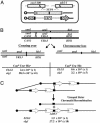ELG1, a yeast gene required for genome stability, forms a complex related to replication factor C
- PMID: 12909721
- PMCID: PMC187881
- DOI: 10.1073/pnas.1633757100
ELG1, a yeast gene required for genome stability, forms a complex related to replication factor C
Abstract
Many overlapping surveillance and repair mechanisms operate in eukaryotic cells to ensure the stability of the genome. We have screened to isolate yeast mutants exhibiting increased levels of recombination between repeated sequences. Here we characterize one of these mutants, elg1. Strains lacking Elg1p exhibit elevated levels of recombination between homologous and nonhomologous chromosomes, as well as between sister chromatids and direct repeats. These strains also exhibit increased levels of chromosome loss. The Elg1 protein shares sequence homology with the large subunit of the clamp loader replication factor C (RFC) and with the product of two additional genes involved in checkpoint functions and genome maintenance: RAD24 and CTF18. Elg1p forms a complex with the Rfc2-5 subunits of RFC that is distinct from the previously described RFC-like complexes containing Rad24 and Ctf18. Genetic data indicate that the Elg1, Ctf18, and Rad24 RFC-like complexes work in three separate pathways important for maintaining the integrity of the genome and for coping with various genomic stresses.
Figures




References
-
- Hartwell, L. H. & Kastan, M. B. (1994) Science 266, 1821–1828. - PubMed
-
- Green, C. M., Erdjument-Bromage, H., Tempst, P. & Lowndes, N. F. (2000) Curr. Biol. 10, 39–42. - PubMed
-
- Burtelow, M. A., Roos-Mattjus, P. M., Rauen, M., Babendure, J. R. & Karnitz, L. M. (2001) J. Biol. Chem. 276, 25903–25909. - PubMed
Publication types
MeSH terms
Substances
LinkOut - more resources
Full Text Sources
Molecular Biology Databases

